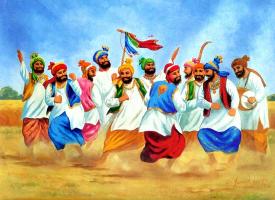 |
Dancing
the bhangra |
Vaisakhi—or Baisakhi—is a North Indian harvest festival celebrated particularly in the Punjab, but also throughout the world wherever there are large populations of Punjabis.
The name of the festival comes from Vaisakh, the month in the Hindu and Punjabi calender during which winter crops are reaped. The intense labour in the fields at this time is lightened by festivities such as the dancing of the bhangra, an incredible show of exuberance that once was believed to invigorate the crops.
Usually it is only men that dance the bhangra; traditional dances that women perform include the gidda, in which the dancers enact verses of folk poetry called bolis, the subject of which covers everything from arguments with relatives to more momentous current affairs.
The Vaisakhi festival is of importance for several of India’s religions. For Sikhs, it is a reminder of the founding of the khalsa in 1699 CE by Guru Gobind Singh; it is also the day that Guru Arjan Das was martyred by the Mughals. In 1875 CE, Swami Dayanand Saraswati chose Vaisakhi as the day to found the Arya Samaj*. And although most Buddhists celebrate the Buddha’s enlightement on Wesak or Bodhi Day, some believe that this actually occurred on Vaisakhi.
For more about the founding of the Sikh khalsa, see Leap of faith. Alternatively view the complete article on sacred history.